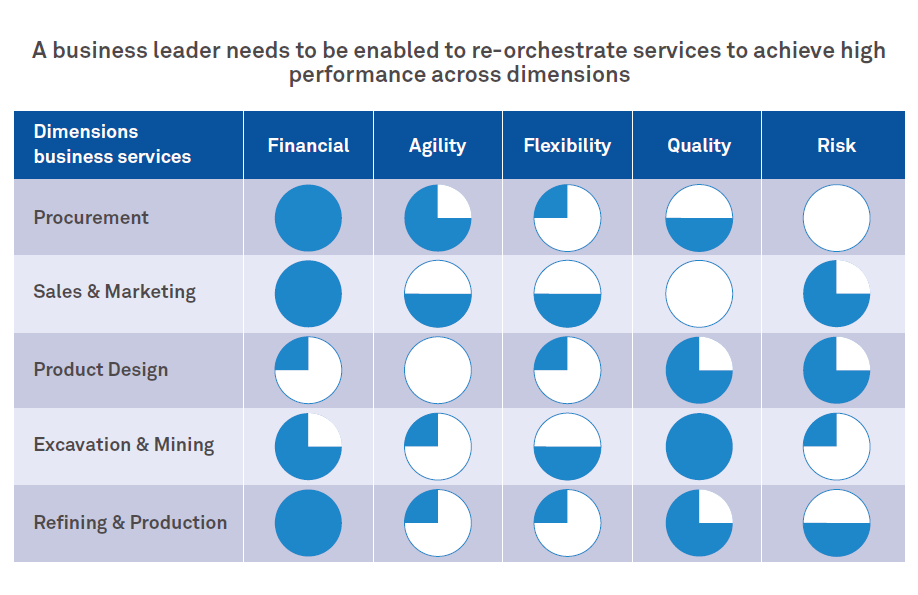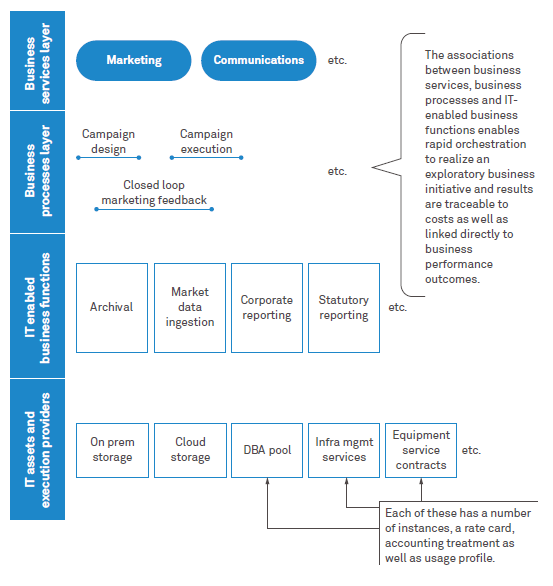Enterprise business leaders need to deal with the new volatile, uncertain, complex and ambiguous world we live in by continuously evolving across what they make, source, and sell, leveraging the constantly evolving platforms, partners and innovations from the ecosystem. Many enterprises have benefited immeasurably from transitioning to an ‘As a Service’ model, but the really exciting possibilities are being handicapped by the lack of next generation service integration and management (which we term SIAM 4.0) and financial management transparency. This dilutes and constrains what enterprises hope to achieve.
Let’s examine the challenges enterprises face, the options they consider to deal with these challenges, and understand how SIAM 4.0 framework and financial transparency assets provide a disruptive enabling alternative.
Continuous orchestration of business services
Typically, an enterprise business leader has to optimize decision-making around various performance ‘dimensions’. Figure 1 illustrates what they might be for an oil services firm, for instance. And based on ‘business services’, the enterprise requires to operate the appropriate combination of how distinct business services individually (partly or fully as reported by the Harvey Balls) achieve specific performance measures, but collectively achieve the optimal state the enterprise requires. This represents what the business leader would like the state of the business to be naturally till market conditions warrant a reset and a new optimum.

Figure 1: Business services orchestration in oil services firm
An enterprise fundamentally executes business services, and thereby delivers revenues and margins to its owners. These business services typically include procurement, manufacturing, workforce management, sales, marketing and order management for the goods and services their customers purchase. These business services are most often manifested as business processes, which execute using a combination of IT-enabled business functions, composed of inhouse or outsourced assets and execution partners. For instance, a supply chain business service for a large apparel firm comprises sourcing, warehousing and logistics processes, which are, in turn, implemented with IT packages as well as execution partners such as a hierarchy of global suppliers, with the whole business service itself managed by in-house and consulting staff. The IT packages run on servers with access to data (storage) and connecting to other internal and external systems (via networks).
When business leaders review the performance of the enterprise (the past) and optimize for the future (based on the forecast), they can usually can only take a ‘tunnel vision’ view by business service. They also often optimize by reducing spend in some areas which they consider excessive. The implications of these kinds of optimization on overall business outcomes are often not clear upfront or even retroactively as there is little traceability and transparency between the worlds of say, business process and IT. So, if the apparel manufacturer decides to optimize its supply chain by switching to a lower cost IT packaged product that reduces the flexibility in logistics and imposes lower margins on suppliers, there could be ‘stock out’ inventory misses in the stores (revenue loss) and negative publicity from bad labor practices with newer suppliers (reputation risk).
Expenses are often arbitrarily allocated across various cost centers. So, when budgets of IT projects that are ongoing (supporting existing processes) are compared with those of IT transformation projects (redesigning some existing process), loose projections of how, say, capital expenditure on the transformation project will reduce operating expenditure on the existing process, are often the basis to fund projects themselves. And there is very little ability, let alone accuracy, of verifying the savings once the project is completed.
We propose a structured hierarchy of linkages of solution elements. First, the linkage of business services to IT-enabled business functions, via business processes. Second, business functions are connected, through a structured taxonomy, with underlying internal or ecosystem foundation services. Therefore, it becomes very easy to see the implications of projects that could span any or all of business services, IT-enabled business functions and underlying foundation services. It also enables transparent consideration between options, right down to decision-making at the lowest level of granularity – such as ‘going to Public Cloud for data ingestion will increase the agility and reduce the cost of the campaign design and execution, but expose the marketing business service to increased risk of GDPR non-compliance’.
SIAM 4.0 framework
The schematic in Figure 2 is the essence of the SIAM 4.0 model and illustrates a representative ‘hierarchy’ of business services, business processes, business functions and then the realization atop IT assets and execution partners.

Figure 2: SIAM 4.0 model
Let’s consider the example of a consumer packaged goods company that is launching a new beverage product. It needs a plan to optimize the business service of consumer marketing. The SIAM 4.0 model will associate the relevant projects and processes (such as channel data ingestion, affinity group identification, outbound campaigns design and execution), with the underlying foundation services (of social media, Big Data, public or private Cloud, marketing platforms, campaigns on various channels and with various partners). This will enable the business to consider the impact on performance dimensions (risk and compliance, revenue increase, margins and quality of outcome).
The SIAM 4.0 framework and associated Intellectual Property catalog links enterprise business services with a set of performance dimensions, generally financial outcomes, flexibility, agility, quality and risk. The business services are associated with processes and naturally, many of those, such as onboarding talent or storing enterprise assets, span multiple services The processes are then associated with assets and execution partners. In an IT context, these would include communications equipment and communication providers, Cloud compute and storage partners as well as on-premises servers and storage networks. Actual expenses of each can then be associated, not just with the business service and linked processes, but even with sustenance or transformation projects and programs.
Overall, it enhances the ability of the enterprise business leaders to be flexible. Sometimes, they can experiment with one orchestrated set of business services and the associated processes and IT-service-enabled business functions, say for a new product launch. They can also have the traceability to financials, allowing them to either ‘fail fast’ or swiftly pivot to succeed the next time by modifying or optimizing up and down the service/process/function/asset and execution chain.
Aditya Dashora
Principal Consultant, CIS, Wipro Ltd.
Ravi Menon
Practice Director, CIS, Wipro Ltd.
Rupreet Soni
General Manager, CIS, Wipro Ltd.
Aditya, Ravi and Rupreet are seasoned professional consulting leaders with extensive global experience in guiding enterprises on how to take advantage of new thinking in pivoting to more efficient ways of execution. They are currently in the Cloud & Infrastructure Consulting Unit of Wipro Ltd.
This point of view was created with valuable inputs from Priyadarshan Shirodkar and Nicholas Bartak, who are leaders in the Applied Services Innovation Center of Wipro Global Consulting Group-this unit devises and deploys Intellectual Property-based mechanisms to increase business/IT alignment in decision-making and operations.